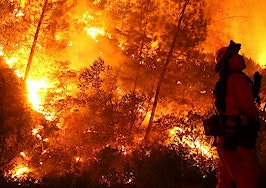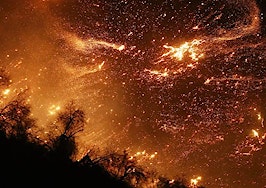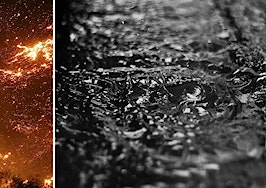Rural areas in California, Colorado and other western states present homeowners with a dilemma. They provide beauty, peace, and quiet along with recreational conveniences and space to store camping gear, vehicles, boats, RVs and other lifestyle accessories. The downside is that one wildfire can turn all those benefits against a household with consequences that are often devastating and sometimes deadly.
The problem of fire risk in these wildland-urban interfaces has been receiving more attention as the population in these areas grows. Adding to the problem, campfires and other human activity account for 90 percent of all wildfires.
Researchers have also linked an increase in wildfire impacts to climate change. Wildfires are consuming larger areas, and the fire season is getting longer. As global temperatures rise, that means wildfire risk in wildland-urban interfaces has nowhere to go but up.
A new study from the University of Las Vegas, Nevada adds an intriguing public policy twist to the mix. The study affirms that the problem may get worse before it gets better, partly because wildfire risks don’t impact property values in fire-prone areas over the long run.
The study, authored by economics professors Shawn J. McCoy and Randall P. Walsh (of the University of Pittsburgh), is titled “Wildfire Risk, Salience & Housing Demand.”
Loosely speaking, salience refers to the human tendency to ignore some environmental factors and focus on others. Salience is part and parcel of the real estate field, and it is clearly at play in the area of study.
The authors looked at eight fire-prone counties in Colorado in the period from 2000 to 2012. They found that property values dipped in the first year or two after a fire, but recovered after that.
McCoy and Walsh credit salience with the growth of the wildland-urban interface. Despite the risks, housing stock in wildland-urban areas nationwide skyrocketed from an estimated 30.8 million housing units in 1990 to 43.4 million units in 2010:
…homebuyers place such a significant premium on homes with the appealing views and beautifully isolating dense vegetation provided by mountainous high-fire risk areas that even media coverage of out-of-control blazes, mass evacuations, or deaths may not deter them.
In a phone conversation with Inman, McCoy explained:
We looked at what happens to the socio-economic dynamic between people, and how fire influences demand. So we asked the question, what is the impact of a recent fire? We found the effect is transitory.
A lot of us are interested in trying to understand what we can do to make homeowners more aware of the risks.
Our findings seem to be consistent with other findings in behavioral economics. People seem to latch on to information that’s readily available, but [the impact fades] as times lapses.
All of this may reassure wildand-urban real estate stakeholders that resale value will hold up over the long run.
However, it also suggest that if individual home buyers keep making high-risk decisions, and if wildfires continue to grow more frequent and intense, more energy will focus on stronger public policies for mitigating risks and avoiding costs for the general public.
There is a public cost for fighting fires, as well as associated emergency response costs, medical costs, and the restoration of damaged infrastructure. These resource impacts involves multiple public agencies. The impacts can also cross state lines and even international boundaries, as major fires draw help from outside of the affected region.
Utility ratepayers and stockholders could also be at risk of financial impact in cases where electrical equipment sparks a blaze — or the public could pick up the tab for that, too.
Property values near fire prone areas may also be impacted. A 2014 review of of the literature suggests that properties within a mile or so of multiple fires can lose value, if not after the first fire then certainly after the second one.
As for the impact on fire fighters, the risks can be mortal. The third-worst single wildfire disaster in US history occurred as recently as 2013, when 19 fire fighters died in the Yarnell Hill fire in Arizona.
From a public policy perspective, the wildfire issue presents an interesting comparison with flood risks. In flood prone inland areas, for example, public policy has begun to focus on buying out properties in areas of chronic flooding, and prohibiting new construction in those areas.
Coastal areas impacted by rising sea levels are also beginning to show signs of desertion and long term, significant property value loss. Researchers have also noted that property values in proximity to flooded parts of a coastal neighborhood can be impacted.
Professor McCoy suggested that a similar dynamic may not deter homeowners in fire prone areas, partly because flood risks are to some extent more knowable.
“Flood risk is more deterministic with respect to flood behavior,” he explained. “Fire is much more random.”













